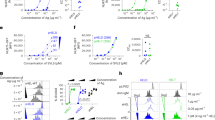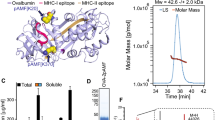Abstract
Vaccines based on recombinant proteins avoid the toxicity and antivector immunity associated with live vaccine (for example, viral) vectors, but their immunogenicity is poor, particularly for CD8+ T-cell responses. Synthetic particles carrying antigens and adjuvant molecules have been developed to enhance subunit vaccines, but in general these materials have failed to elicit CD8+ T-cell responses comparable to those for live vectors in preclinical animal models. Here, we describe interbilayer-crosslinked multilamellar vesicles formed by crosslinking headgroups of adjacent lipid bilayers within multilamellar vesicles. Interbilayer-crosslinked vesicles stably entrapped protein antigens in the vesicle core and lipid-based immunostimulatory molecules in the vesicle walls under extracellular conditions, but exhibited rapid release in the presence of endolysosomal lipases. We found that these antigen/adjuvant-carrying vesicles form an extremely potent whole-protein vaccine, eliciting endogenous T-cell and antibody responses comparable to those for the strongest vaccine vectors. These materials should enable a range of subunit vaccines and provide new possibilities for therapeutic protein delivery.
This is a preview of subscription content, access via your institution
Access options
Subscribe to this journal
Receive 12 print issues and online access
$259.00 per year
only $21.58 per issue
Buy this article
- Purchase on Springer Link
- Instant access to full article PDF
Prices may be subject to local taxes which are calculated during checkout





Similar content being viewed by others
References
Guy, B. The perfect mix: Recent progress in adjuvant research. Nature Rev. Microbiol. 5, 505–517 (2007).
Perrie, Y., Mohammed, A. R., Kirby, D. J., McNeil, S. E. & Bramwell, V. W. Vaccine adjuvant systems: Enhancing the efficacy of sub-unit protein antigens. Int. J. Pharm. 364, 272–280 (2008).
Reed, S. G., Bertholet, S., Coler, R. N. & Friede, M. New horizons in adjuvants for vaccine development. Trends Immunol. 30, 23–32 (2009).
Walker, B. D. & Burton, D. R. Toward an AIDS vaccine. Science 320, 760–764 (2008).
Haglund, K. et al. Robust recall and long-term memory T-cell responses induced by prime-boost regimens with heterologous live viral vectors expressing human immunodeficiency virus type 1 Gag and Env proteins. J. Virol. 76, 7506–7517 (2002).
Flatz, L. et al. Development of replication-defective lymphocytic choriomeningitis virus vectors for the induction of potent CD8+ T cell immunity. Nature Med. 16, 339–345 (2010).
Brave, A., Ljungberg, K., Wahren, B. & Liu, M. A. Vaccine delivery methods using viral vectors. Mol. Pharm. 4, 18–32 (2007).
Priddy, F. H. et al. Safety and immunogenicity of a replication-incompetent adenovirus type 5 HIV-1 clade B gag/pol/nef vaccine in healthy adults. Clin. Infect. Dis. 46, 1769–1781 (2008).
Hubbell, J. A., Thomas, S. N. & Swartz, M. A. Materials engineering for immunomodulation. Nature 462, 449–460 (2009).
Heath, W. R. & Carbone, F. R. Cross-presentation in viral immunity and self-tolerance. Nature Rev. Immunol. 1, 126–134 (2001).
Kwon, Y. J., James, E., Shastri, N. & Frechet, J. M. In vivo targeting of dendritic cells for activation of cellular immunity using vaccine carriers based on pH-responsive microparticles. Proc. Natl Acad. Sci. USA 102, 18264–18268 (2005).
Hamdy, S. et al. Enhanced antigen-specific primary CD4+ and CD8+ responses by codelivery of ovalbumin and toll-like receptor ligand monophosphoryl lipid A in poly(D,L-lactic-co-glycolic acid) nanoparticles. J. Biomed. Mater. Res. A 81, 652–662 (2007).
Heit, A., Schmitz, F., Haas, T., Busch, D. H. & Wagner, H. Antigen co-encapsulated with adjuvants efficiently drive protective T cell immunity. Eur. J. Immunol. 37, 2063–2074 (2007).
Schlosser, E. et al. TLR ligands and antigen need to be coencapsulated into the same biodegradable microsphere for the generation of potent cytotoxic T lymphocyte responses. Vaccine 26, 1626–1637 (2008).
Heffernan, M. J., Kasturi, S. P., Yang, S. C., Pulendran, B. & Murthy, N. The stimulation of CD8+ T cells by dendritic cells pulsed with polyketal microparticles containing ion-paired protein antigen and poly(inosinic acid)-poly(cytidylic acid). Biomaterials 30, 910–918 (2009).
Demento, S. L. et al. Inflammasome-activating nanoparticles as modular systems for optimizing vaccine efficacy. Vaccine 27, 3013–3021 (2009).
Reddy, S. T. et al. Exploiting lymphatic transport and complement activation in nanoparticle vaccines. Nature Biotechnol. 25, 1159–1164 (2007).
Torchilin, V. P. Recent advances with liposomes as pharmaceutical carriers. Nature Rev. Drug Discov. 4, 145–160 (2005).
Gregoriadis, G., Gursel, I., Gursel, M. & McCormack, B. Liposomes as immunological adjuvants and vaccine carriers. J. Control. Release 41, 49–56 (1996).
Jeong, J. M., Chung, Y. C. & Hwang, J. H. Enhanced adjuvantic property of polymerized liposome as compared to a phospholipid liposome. J. Biotechnol. 94, 255–263 (2002).
Vangala, A. et al. Comparison of vesicle based antigen delivery systems for delivery of hepatitis B surface antigen. J. Control. Release 119, 102–110 (2007).
Steers, N. J., Peachman, K. K., McClain, S., Alving, C. R. & Rao, M. Liposome-encapsulated HIV-1 Gag p24 containing lipid A induces effector CD4+ T-cells, memory CD8+ T-cells, and pro-inflammatory cytokines. Vaccine 27, 6939–6949 (2009).
Bhowmick, S., Mazumdar, T., Sinha, R. & Ali, N. Comparison of liposome based antigen delivery systems for protection against Leishmania donovani. J. Control. Release 141, 199–207 (2010).
Reddy, R., Zhou, F., Nair, S., Huang, L. & Rouse, B. T. In vivo cytotoxic T lymphocyte induction with soluble proteins administered in liposomes. J. Immunol. 148, 1585–1589 (1992).
Collins, D. S., Findlay, K. & Harding, C. V. Processing of exogenous liposome-encapsulated antigens in vivo generates class I MHC-restricted T cell responses. J. Immunol. 148, 3336–3341 (1992).
Wakita, D. et al. An indispensable role of type-1 IFNs for inducing CTL-mediated complete eradication of established tumor tissue by CpG-liposome co-encapsulated with model tumor antigen. Int. Immunol. 18, 425–434 (2006).
Popescu, M. C. et al. A novel proteoliposomal vaccine elicits potent antitumor immunity in mice. Blood 109, 5407–5410 (2007).
Allen, T. M., Mumbengegwi, D. R. & Charrois, G. J. Anti-CD19-targeted liposomal doxorubicin improves the therapeutic efficacy in murine B-cell lymphoma and ameliorates the toxicity of liposomes with varying drug release rates. Clin. Cancer. Res. 11, 3567–3573 (2005).
Cashion, M. P. & Long, T. E. Biomimetic design and performance of polymerizable lipids. Acc. Chem. Res. 42, 1016–1025 (2009).
Hotz, J. & Meier, W. Vesicle-templated polymer hollow spheres. Langmuir 14, 1031–1036 (1998).
Mahadevan, S. & Tappel, A. L. Lysosomal lipases of rat liver and kidney. J. Biol. Chem. 243, 2849–2854 (1968).
Papahadjopoulos, D., Nir, S. & Duzgunes, N. Molecular mechanisms of calcium-induced membrane fusion. J. Bioenerg. Biomembr. 22, 157–179 (1990).
Zauner, W., Farrow, N. A. & Haines, A. M. In vitro uptake of polystyrene microspheres: Effect of particle size, cell line and cell density. J. Control. Release 71, 39–51 (2001).
Mohammed, A. R., Bramwell, V. W., Coombes, A. G. & Perrie, Y. Lyophilisation and sterilisation of liposomal vaccines to produce stable and sterile products. Methods 40, 30–38 (2006).
Girard, P. et al. A new method for the reconstitution of membrane proteins into giant unilamellar vesicles. Biophys. J. 87, 419–429 (2004).
Lutsiak, M. E., Robinson, D. R., Coester, C., Kwon, G. S. & Samuel, J. Analysis of poly(D,L-lactic-co-glycolic acid) nanosphere uptake by human dendritic cells and macrophages in vitro. Pharm. Res. 19, 1480–1487 (2002).
Huisgen, R. Cycloadditions—definition classification and characterization. Angew. Chem. Int. Ed. 7, 321 (1968).
Wang, Q. et al. Bioconjugation by copper(I)-catalyzed azide-alkyne [3+2] cycloaddition. J. Am. Chem. Soc. 125, 3192–3193 (2003).
Allen, T. M. & Cullis, P. R. Drug delivery systems: Entering the mainstream. Science 303, 1818–1822 (2004).
Mundargi, R. C., Babu, V. R., Rangaswamy, V., Patel, P. & Aminabhavi, T. M. Nano/micro technologies for delivering macromolecular therapeutics using poly(D,L-lactide-co-glycolide) and its derivatives. J. Control. Release 125, 193–209 (2008).
Vasir, J. K. & Labhasetwar, V. Biodegradable nanoparticles for cytosolic delivery of therapeutics. Adv. Drug Deliv. Rev. 59, 718–728 (2007).
Gabizon, A. et al. Prolonged circulation time and enhanced accumulation in malignant exudates of doxorubicin encapsulated in polyethylene-glycol coated liposomes. Cancer Res. 54, 987–992 (1994).
Kirby, C. & Gregoriadis, G. Dehydration–rehydration vesicles—a simple method for high-yield drug entrapment in liposomes. Bio/Technology 2, 979–984 (1984).
Bershteyn, A. et al. Polymer-supported lipid shells, onions, and flowers. Soft Matter 4, 1787–1791 (2008).
McKee, A. S., Munks, M. W. & Marrack, P. How do adjuvants work? Important considerations for new generation adjuvants. Immunity 27, 687–690 (2007).
Mata-Haro, V. et al. The vaccine adjuvant monophosphoryl lipid A as a TRIF-biased agonist of TLR4. Science 316, 1628–1632 (2007).
Porgador, A., Yewdell, J. W., Deng, Y., Bennink, J. R. & Germain, R. N. Localization, quantitation, and in situ detection of specific peptide–MHC class I complexes using a monoclonal antibody. Immunity 6, 715–726 (1997).
Sallusto, F., Geginat, J. & Lanzavecchia, A. Central memory and effector memory T cell subsets: Function, generation, and maintenance. Annu. Rev. Immunol. 22, 745–763 (2004).
Yadava, A. et al. A novel chimeric Plasmodium vivax circumsporozoite protein induces biologically functional antibodies that recognize both VK210 and VK247 sporozoites. Infect. Immun. 75, 1177–1185 (2007).
Ellman, G. L. Tissue sulfhydryl groups. Arch. Biochem. Biophys. 82, 70–77 (1959).
Acknowledgements
This work was supported in part by the Ragon Institute of MGH, MIT and Harvard, the Gates Foundation, the Department. of Defense (contract W911NF-07-D-0004) and the National Institutes of Health (P41RR002250 and RC2GM092599). The authors would like to thank A. Yadava for providing the VMP antigen. D.J.I. is an investigator of the Howard Hughes Medical Institute.
Author information
Authors and Affiliations
Contributions
J.J.M. and D.J.I. designed the experiments. J.J.M. carried out the experiments; H.S. assisted in the in vivo characterization and immunization studies. A.B., H.K., J.T.G., J.R. and W.C. contributed cryoelectron microscope imaging. M.T.S. and S.H.U. contributed experimental suggestions. H.L., B.H., M.S. and S.L. provided technical support. J.J.M. and D.J.I. analysed the data and wrote the paper.
Corresponding author
Ethics declarations
Competing interests
The authors declare no competing financial interests.
Supplementary information
Supplementary Information
Supplementary Information (PDF 7239 kb)
Rights and permissions
About this article
Cite this article
Moon, J., Suh, H., Bershteyn, A. et al. Interbilayer-crosslinked multilamellar vesicles as synthetic vaccines for potent humoral and cellular immune responses. Nature Mater 10, 243–251 (2011). https://doi.org/10.1038/nmat2960
Received:
Accepted:
Published:
Issue Date:
DOI: https://doi.org/10.1038/nmat2960
This article is cited by
-
Advances in functional lipid nanoparticles: from drug delivery platforms to clinical applications
3 Biotech (2024)
-
Aromatized liposomes for sustained drug delivery
Nature Communications (2023)
-
Antitumor activities of novel glycyrrhetinic acid-modified lipogel hybrid system in vitro
Journal of Materials Science (2023)
-
Nanoparticle elasticity affects systemic circulation lifetime by modulating adsorption of apolipoprotein A-I in corona formation
Nature Communications (2022)
-
Emerging strategies for biomaterial-assisted cancer immunotherapy
Korean Journal of Chemical Engineering (2022)



